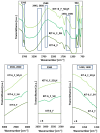Generation of Acid Sites in Nanostructured KIT-6 Using Different Methods to Obtain Efficient Acidic Catalysts for Glycerol Acetalization to Solketal
- PMID: 39683672
- PMCID: PMC11643615
- DOI: 10.3390/molecules29235512
Generation of Acid Sites in Nanostructured KIT-6 Using Different Methods to Obtain Efficient Acidic Catalysts for Glycerol Acetalization to Solketal
Abstract
This study explored the preparation of pure silica KIT-6, as well as KIT-6 materials with an enhanced concentration of surface OH groups through aluminum incorporation or NH4F treatment. These materials with various contents of surface OH groups were subsequently modified via the post-synthesis grafting of sulfonic groups using 3-mercaptopropyltrimethoxysilane as a precursor, followed by oxidation to introduce acidic sites. The catalysts were thoroughly characterized using XRD, nitrogen adsorption/desorption, SEM-EDS, TEM, and FT-IR techniques to confirm their structural and chemical properties. The catalytic activity of acid-functionalized mesoporous silicas of the KIT-6 structure was further evaluated in the acetalization of glycerol to produce solketal. The results demonstrated a significant influence of the surface OH group concentration and acidic site density on catalytic performance, with KIT-6_F_SO3H showing the highest efficiency in glycerol-to-solketal conversion. This study provides valuable insights into the design of efficient catalytic systems for the valorization of biodiesel-derived glycerol into high-value chemicals, offering a sustainable approach to waste glycerol utilization.
Keywords: KIT-6 modification; KIT-6 synthesis; acidic active centers; glycerol acetalization; grafting of sulfonic groups; solketal.
Conflict of interest statement
The authors declare no conflicts of interest.
Figures












References
-
- Zhang P., He M., Teng W., Li F., Qiu X., Li K., Wang H. Ordered mesoporous materials for water pollution treatment: Adsorption and catalysis. Green Energy Environ. 2024;9:1239–1256. doi: 10.1016/j.gee.2023.11.001. - DOI
-
- Gangadhar J., Tirumuruhan B., Sujith R. Applications and Future Trends in Mesoporous Materials. In: Uthaman A., Thomas S., Li T., Maria H., editors. Advanced Functional Porous Materials; Engineering Materials. Springer; Berlin/Heidelberg, Germany: 2022. pp. 235–258. - DOI
LinkOut - more resources
Full Text Sources

